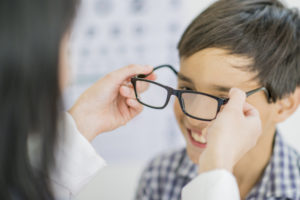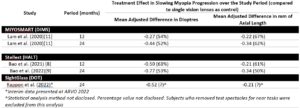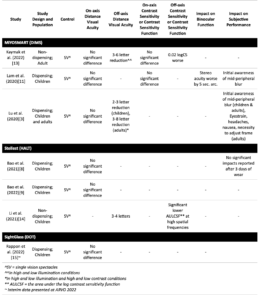June 1, 2022
By Dean Psarakis, B.Optom, Senior Research Optometrist, Brien Holden Vision Institute
Novel spectacle designs comprising D.I.M.S., H.A.L.T., and D.O.T. technology slow myopia. They are a significant value-add to the suite of myopia management options, as they can be easily fitted even in young children and require minimal care.

Whilst the argument for reducing the risk of the eye reaching high myopia is well established, it has been said that as little as one diopter reduction may still have significant benefits when it comes to quality of vision, long-term ocular disease reduction, and quality of life.1 Of the suite of currently available myopia management strategies, spectacles present a convenient and minimally intrusive option, especially for children under 12 years of age.2 This article will explore three options available on the market, their optical design, efficacy, and vision quality.
Design and Hypotheses for Myopia Control
MiYOSMART with D.I.M.S. Technology (Hoya Lens, Japan)
Developed by the Hong Kong Polytechnic University in association with Hoya, this lens uses a Defocus Incorporated Multiple Segments (DIMS) design. The lens incorporates a clear central zone that is 9 mm in diameter and corrects the patient’s refractive error. The mid-peripheral portion consists of a honeycomb-like section of tiny optical segments (approximately 1 mm diameter), each of +3.50D power. The portion comprising the segments, extending outwards and totaling approximately 33mm in diameter.3 This creates an area of peripheral myopic defocus at the retina, and hypothesized as a mechanism underlying the inhibition/slowing of axial length elongation.4-6
Stellest with H.A.L.T. Technology (Essilor, France)
In 2018, Essilor launched a three-year clinical trial in conjunction with the Wenzhou Medical University, China, that aimed to evaluate efficacy of its Stellest lens for myopia control. This lens utilizes a Highly Aspheric Lenslet Target (HALT) design, comprising a constellation of 11 concentric rings of small aspheric lenslets radiating out peripherally (out to lens edge) from a clear central zone of 9 mm diameter.7 It is suggested that the aspheric lenslets arranged across the lens create a power gradient that increases the volume of myopic defocus at the retina that aids in slowing myopia.8,9
SightGlass with D.O.T. Technology (SightGlass Vision, USA)
In this novel approach to myopia management, the spectacle lens design utilizes light diffusion technology. The technology, named Diffusion Optics Technology (DOT) incorporates thousands of microscopic light-scattering elements dispersed/positioned through the lens, sparing a small central clear zone. This optical design uses non-vergence optics to achieve a contrast reduction at the retina between adjacent photoreceptors, and thus deviates from the peripheral retinal defocus hypothesis.10
Efficacy
Whilst efficacy data for all three spectacle lenses have been presented at various forums, at the time of this article, published peer-reviewed data is available for MiYOSMART and Stellest only. Table 1 summarizes the data and it appears that significant reduction in progression is feasible with these spectacle lens designs.

Table 1. Clinical studies on myopia progression management with MiYOSMART (DIMS), Stellest (HALT), and SightGlass (DOT).
Vision Quality
Whilst measures of efficacy are understandably of most interest with respect to myopia control lenses, vision quality afforded through these spectacles are important for subjective acceptance and long-term wear of these designs. On this aspect, there have been reports on vision quality with wear of MiYOSMART3,13 and Stellest.14 No published data is available on SightGlass as yet. Table 2 summarizes data from the relevant publications. Overall, these indicate no effect on central visual acuity and contrast sensitivity, with some reduction in off-axis visual performance (off-axis refers to the peripheral portion that comprise the multi-segments or aspherical lenslets). Off-axis visual acuity was reduced by approximately one line in MiYOSMART and Stellest. Similarly, off-axis contrast sensitivity was reduced, particularly at higher spatial frequencies. There is little data on subjective performance, but early insight from Lu et al.3suggest children are aware of peripheral blur, but only initially (at least with DIMS and HALT).

Table 2. Clinical studies that reference quality of vision in MiYOSMART (DIMS), Stellest (HALT), and SightGlass (DOT).
Summary
It is clear that novel spectacle designs comprising defocus incorporated multiple-segments, aspherical lenslets, and DOT technology slow myopia. They are a significant value-add to the suite of myopia management options as they can be fitted with ease even in young children and require minimal care. However, owing to the nature of these spectacle lens designs, practitioners need to be aware that especially in the early days post lens fitting, there may be some visual performance issues especially with off-axis viewing that may take some time to adapt to.
 |
Dean Psarakis, B.Optom, is an Australian optometrist who has completed his Masters in International Health at the Vrij University in Amsterdam, The Netherlands. He has a keen passion for working within indigenous populations and in lower income settings globally. He is currently pursuing a career in vision research with BHVI. |
References
1 M. A. Bullimore and N. A. Brennan, “Myopia Control: Why Each Diopter Matters,” Optometry and Vision Science, vol. 96, no. 6, pp. 463–465, Jun. 2019, doi: 10.1097/OPX.0000000000001367.
2 Y.-K. ; Kuo et al., “Citation: Efficacy of Myopia Control and Distribution of Corneal Epithelial Thickness in Children Treated with Orthokeratology Assessed Using,” 2022, doi: 10.3390/jpm12020278.
3 Y. Lu et al., “The Adaptation and Acceptance of Defocus Incorporated Multiple Segment Lens for Chinese Children,” American Journal of Ophthalmology, vol. 211, pp. 207–216, Mar. 2020, doi: 10.1016/J.AJO.2019.12.002.
4 J. Wallman and J. Winawer, “Homeostasis of eye growth and the question of myopia,” Neuron, vol. 43, no. 4, pp. 447–468, Aug. 2004, doi: 10.1016/J.NEURON.2004.08.008.
5 D. Troilo et al., “IMI – Report on Experimental Models of Emmetropization and Myopia,” Invest Ophthalmol Vis Sci, vol. 60, no. 3, pp. M31–M88, Feb. 2019, doi: 10.1167/IOVS.18-25967.
6 S. A. Tay, S. Farzavandi, and D. Tan, “Interventions to Reduce Myopia Progression in Children,” Strabismus, vol. 25, no. 1, pp. 23–32, Jan. 2017, doi: 10.1080/09273972.2016.1276940.
7 H. Zhang et al., “Myopia Control Effect Is Influenced by Baseline Relative Peripheral Refraction in Children Wearing Defocus Incorporated Multiple Segments (DIMS) Spectacle Lenses,” J Clin Med, vol. 11, no. 9, May 2022, doi: 10.3390/JCM11092294
8 J. Bao et al., “One-year myopia control efficacy of spectacle lenses with aspherical lenslets,” Br J Ophthalmol, vol. 0, pp. 1–6, 2021, doi: 10.1136/bjophthalmol-2020-318367.
9 J. Bao et al., “Spectacle Lenses With Aspherical Lenslets for Myopia Control vs Single-Vision Spectacle Lenses: A Randomized Clinical Trial,” JAMA Ophthalmol, Mar. 2022, doi: 10.1001/JAMAOPHTHALMOL.2022.0401.
10 “Experiencing SightGlass Vision’s Spectacle Lenses – Review of Myopia Management.” https://reviewofmm.com/initial-clinical-experience-with-sightglass-vision-diffusion-optics-technology-spectacle-lenses/ (accessed May 16, 2022).
11 C. S. Y. Lam et al., “Defocus Incorporated Multiple Segments (DIMS) spectacle lenses slow myopia progression: a 2-year randomised clinical trial,” Br J Ophthalmol, vol. 104, no. 3, pp. 363–368, Mar. 2020, doi: 10.1136/BJOPHTHALMOL-2018-313739.
12 C. S. Y. Lam et al., “Myopia control effect of defocus incorporated multiple segments (DIMS) spectacle lens in Chinese children: results of a 3-year follow-up study,” Br J Ophthalmol, 2021, doi: 10.1136/BJOPHTHALMOL-2020-317664.
13 H. Kaymak et al., “Vision tests on spectacle lenses and contact lenses for optical myopia correction: a pilot study.,” BMJ Open Ophthalmol, vol. 7, no. 1, p. e000971, 2022, doi: 10.1136/bmjophth-2022-000971.
14 X. Li et al., “Influence of Lenslet Configuration on Short-Term Visual Performance in Myopia Control Spectacle Lenses,” Frontiers in Neuroscience, vol. 15, May 2021, doi: 10.3389/FNINS.2021.667329.
15 “SightGlass Vision Presents 24-Month Data Demonstrating Myopia Control Efficacy for Vision Spectacle Lenses.” https://eyewire.news/news/sightglass-vision-presents-24-month-data-demonstrating-myopia-control-efficacy-for-vision-spectacle-lenses?c4src=article:infinite-scroll (accessed May 17, 2022).













